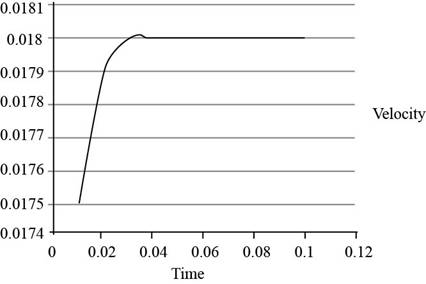
Concept explainers
The variation of velocity with time.
The graph between the variations of velocity with time.
Time taken by ball to reach
Answer to Problem 111P
The time taken to reach
The graph between the variations of velocity with time is.

Explanation of Solution
Given information:
The diameter of the ball is
The below figure represent the free body diagram of the ball.

Figure-(1)
Write the expression of net force acting on the ball.
Here, the weight of the ball is
Write the expression of weight of the ball.
Here, the mass of the ball is
Write the expression of bouncy force.
Here, the mass of the fluid is
Substitute
Write the expression of the mass of the ball.
Here, the density of the ball is
Write the expression of the mass of the fluid.
Here, the density of the fluid is
Substitute
Write the expression of net force by Newton's law of motion.
Here, the acceleration is
Write the expression of acceleration.
Here, the change of velocity with respect to time is
Substitute
Substitute
Write the expression of volume of the ball.
Here, the diameter of the ball is
Write the expression of drag force by using strokes equation.
Here, the dynamic viscosity is
Substitute
Integrate Equation (VI) on both sides as initial velocity is
Substitute
Calculation:
Substitute
Substitute
Substitute
The time taken to reach
Substitute
The variation of velocity with time.
| Time | Velocity |
The graph between the variation of velocity with time is.

Figure-(2)
Conclusion:
The time taken to reach
Want to see more full solutions like this?
Chapter 11 Solutions
Fluid Mechanics: Fundamentals and Applications
- Explain the difference between a favorable and an adverse pressure gradient in a boundary layer. In which case does the pressure increase downstream? Why?arrow_forwardEvaluate the boundary-layer shape factor, H.arrow_forwardJoe can pedal his bike at 10 m/s on a straight levelroad with no wind. The rolling resistance of his bike is0.80 N ? s/m—that is, 0.80 N of force per m/s of speed.The drag area (CDA) of Joe and his bike is 0.422 m2.Joe’s mass is 80 kg and that of the bike is 15 kg. He nowencounters a headwind of 5.0 m/s. (a) Develop an equationfor the speed at which Joe can pedal into the wind. Hint:A cubic equation for V will result. (b) Solve for V; thatis, how fast can Joe ride into the headwind? (c) Why isthe result not simply 10 -5.0 = 5.0 m/s, as one mightfi rst suspect?arrow_forward
- A circular sign has a diameter of 52 cm and is subjected to normal winds up to 160 km/h at 10°C and 100 kPa. Determine the drag force acting on the sign. Also, determine the bending moment at the bottom of its pole, whose height from the ground to the bottom of the sign is 1.5 m. Disregard the drag on the pole.arrow_forwardLocal boundary layer effects, such as shear stress and heattransfer, are best correlated with local variables, rather usingdistance x from the leading edge. The momentum thicknessθ is often used as a length scale. Use the analysis of turbulentflat-plate flow to write local wall shear stress τw in terms ofdimensionless θ and compare with the formula recommendedby Schlichting: Cf ≈ 0.033 Reθ -0.268.arrow_forwardEngine oil at 40°C flows over a 20-m-long & 3-m-wide smooth flat plate with a free-streamvelocity of 50 m/s. Determine the drag force acting on upper side of the plate when:a) Flow is parallel to plate length.b) Flow is parallel to plate width. kindly give me the correct solution.arrow_forward
- How do you recognize a boundary layer? Cite some physicalproperties and some measurements that reveal appropriatecharacteristics.arrow_forwardA slipper-pad bearing with linearly decreasing gap height is being designed for an amusement park ride. Its dimensions are h0 = 1/1000 in (2.54 × 10−5 m), hL = 1/2000 in (1.27 × 10−5 m), and L = 1.0 in (0.0254 m). The lower plate moves at speed V = 10.0 ft/s (3.048 m/s) relative to the upper plate. The oil is engine oil at 40°C. Discuss what happens when the oil temperature increases significantly as the slipper-pad bearing is subjected to constant use at the amusement park. In particular, would the load-carrying capacity increase or decrease? Why?arrow_forwardA vertical air stream flowing at a velocity of 100 m/s supports a ball of 60 mm in diameter. Taking the density of air as 1.2 kg/m³ and kinematic viscosity as 1.6 stokes, the weight of the ball that is supported is (if coefficient of drag C= 0.8)arrow_forward
- On a flat plate; Explain the boundary layer thickness, displacement thickness and momentum thickness by drawing a figure.arrow_forwardWater flows at a velocity of 1.2 m/s over a flat plate 1.2 m long. Assume 1/7thpower law and determine the boundary layer thickness and displacementthickness. Compare the values with values calculated using laminar flowcorrelations. υ = 1 × 10−6m2/s.arrow_forwardThrust is required to propel an airplane at a fi nite forwardvelocity. Does this imply an energy loss to the system?Explain the concepts of thrust and drag in terms of the fi rstlaw of thermodynamics.arrow_forward
 Elements Of ElectromagneticsMechanical EngineeringISBN:9780190698614Author:Sadiku, Matthew N. O.Publisher:Oxford University Press
Elements Of ElectromagneticsMechanical EngineeringISBN:9780190698614Author:Sadiku, Matthew N. O.Publisher:Oxford University Press Mechanics of Materials (10th Edition)Mechanical EngineeringISBN:9780134319650Author:Russell C. HibbelerPublisher:PEARSON
Mechanics of Materials (10th Edition)Mechanical EngineeringISBN:9780134319650Author:Russell C. HibbelerPublisher:PEARSON Thermodynamics: An Engineering ApproachMechanical EngineeringISBN:9781259822674Author:Yunus A. Cengel Dr., Michael A. BolesPublisher:McGraw-Hill Education
Thermodynamics: An Engineering ApproachMechanical EngineeringISBN:9781259822674Author:Yunus A. Cengel Dr., Michael A. BolesPublisher:McGraw-Hill Education Control Systems EngineeringMechanical EngineeringISBN:9781118170519Author:Norman S. NisePublisher:WILEY
Control Systems EngineeringMechanical EngineeringISBN:9781118170519Author:Norman S. NisePublisher:WILEY Mechanics of Materials (MindTap Course List)Mechanical EngineeringISBN:9781337093347Author:Barry J. Goodno, James M. GerePublisher:Cengage Learning
Mechanics of Materials (MindTap Course List)Mechanical EngineeringISBN:9781337093347Author:Barry J. Goodno, James M. GerePublisher:Cengage Learning Engineering Mechanics: StaticsMechanical EngineeringISBN:9781118807330Author:James L. Meriam, L. G. Kraige, J. N. BoltonPublisher:WILEY
Engineering Mechanics: StaticsMechanical EngineeringISBN:9781118807330Author:James L. Meriam, L. G. Kraige, J. N. BoltonPublisher:WILEY





